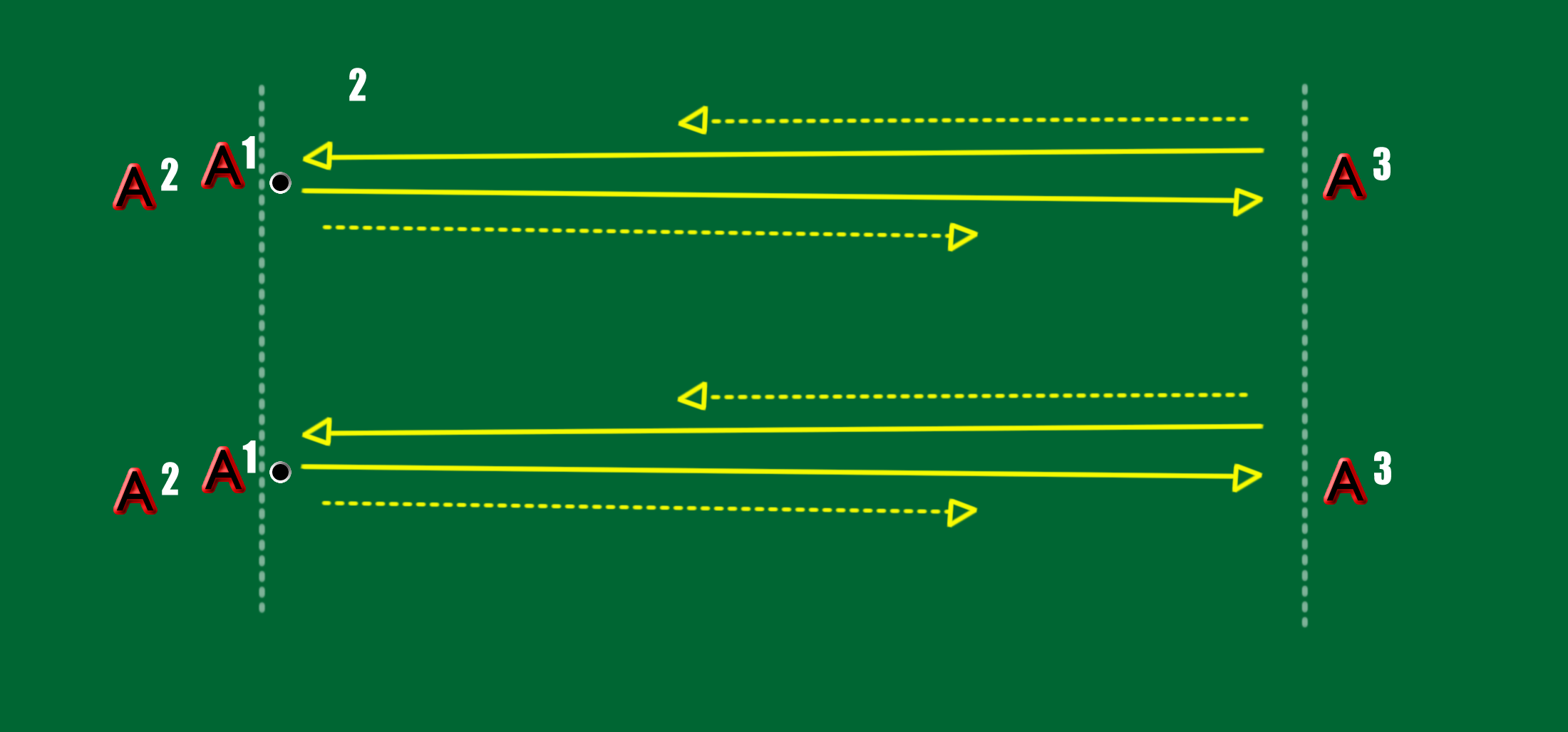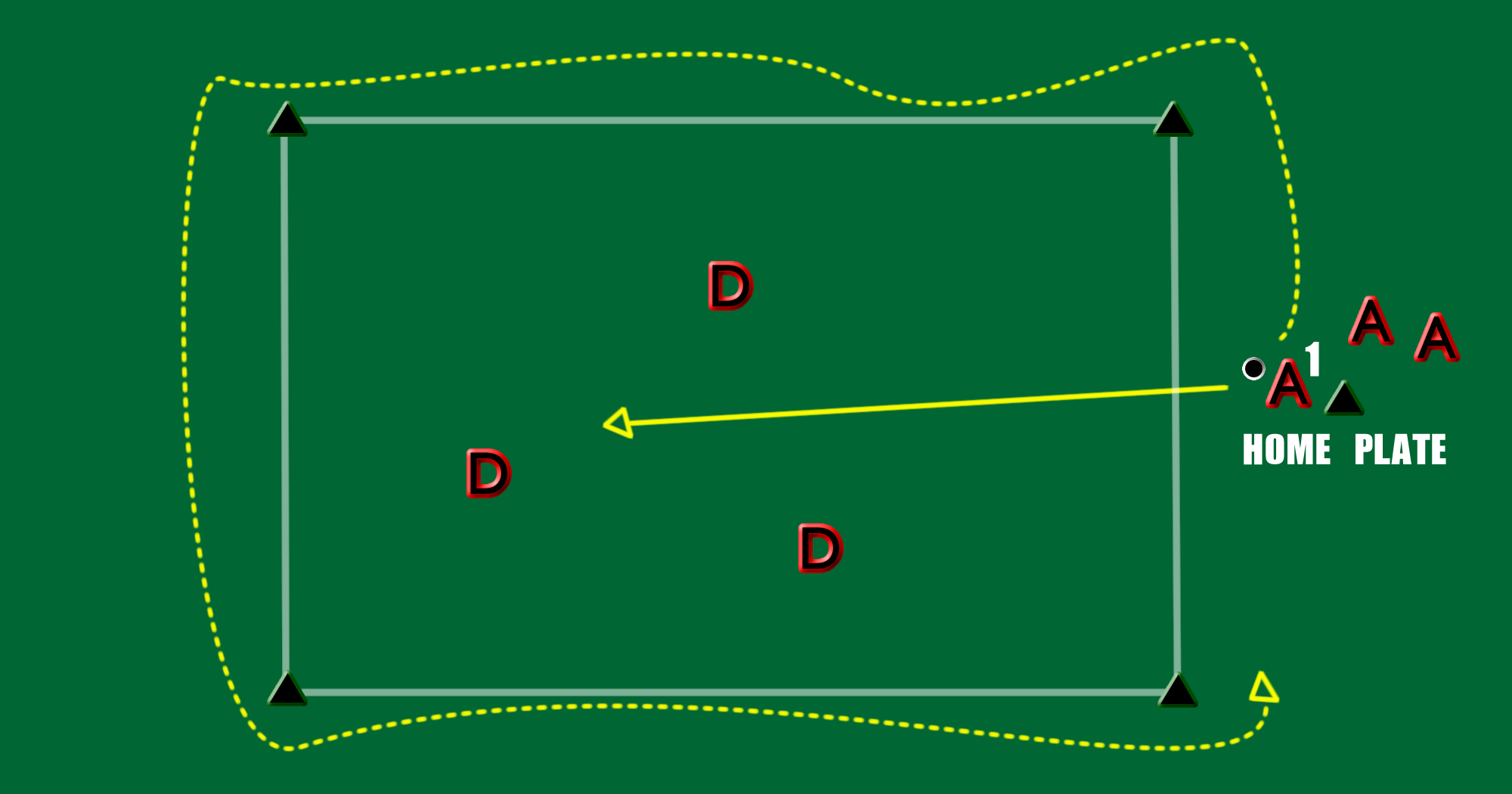FUNSTIX - Lesson 3
THEMES - FMS: shuffle, agility footwork, sidesteps, shuffle steps, rolling a ball, absorbing force, bending, twisting
TECHNICAL: Review ball control, receiving the ball on the forehand (flat stick side reception)
TACTICAL: Providing targets for the player with the ball
Activity 1 i) 5 minutes All Aboard; Players are in scattered formation facing the instructor. The instructor explains the following commands to the players; bow (forward), stern (back), starboard (right), port (left), scrub the deck (a broom sweeping motion); crow’s nest (basic stance) captain hook (move on one leg only); The instructor calls out various commands and the players follow; instructors should vary the locomotor patterns that the players are using and vary the timing of the commands. Players will ‘sink the ship’ if they all move to the front, back, or either side; if this happens, players have to refloat the ship by sprinting to a well balanced formation and assume ready position.
ii) 6 minutes Receive and Run Players are in pairs of equal skill level scattered throughout the playing area. Each pair has one ball. Each pair of players move around the playing area (vary footwork pattern e.g. - side steps, skip, jog, shuffle step), staying 5 yards apart, rolling the ball to each other so that it is easy to receive. Instructors should emphasize correct technique for rolling and absorbing the ball and emphasize that players need to bend their knees and flex their hips when rolling and receiving. Each pair should be trying to find open space as they move around the area. They must constantly be trying to stay away form other players. After each pass, the passer must move to a different space….either, behind, beside, or in front of the person they passed to.
iii) 6 minutes Players are lined up in pairs along a line. Each pair moves from one end line to the other 20 yards away. After the ball is rolled, the passer must move to a different space before the pass is returned. After they roll the ball, passers can move ahead of, beside, or behind the player they passed to. When the ball is received, the receiver must stop, assume the basic stance then roll the ball.
Activity 2: Forehand receptions
i) 4 minutes Players should be positioned is a semi circle so that they can all see and hear the instructor. The instructor demonstrates the open faced, forehand, reception technique first without the ball, then receives a ball that is rolled to them. Players should then all demonstrate the correct position so that the instructor can check for errors.
ii) 8 minutes Players are assigned partners of equal skill ability. Each pair has 2 hockey balls. Players stand 10 yards apart, facing each other. All pairs should be lined up beside each other 10 yards apart. One player (A1) rolls the first ball to the other player, who receives the ball with their stick in the correct position; then the second ball is rolled to the receiver. Once both balls have been received; the roles are reversed. Players repeat this sequence 10 times. MAKE THIS ACTIVITY HARDER: the ball should be rolled to the left and right of the receiver who has to move their feet to get behind the ball to receive it on their strong side; the distance between the players can be decreased; the players try to make as many passes as possible in 20 seconds.
iii) 8 minutes Follow the Ball Shuttle formation. Two players (A1, A2) of each group of 3 stand one behind the other on a line. The third member of the group (A3), stands opposite on another line 10 yards away. A1 rolls the ball towards A3 who moves forward to receive the ball with the stick. A1 moves to take the place of A3 using shuffle steps. After receiving the ball, A3 picks up the ball and rolls it to A2 who receive s the ball with the stick, picks up the ball and rolls it to A1. There should be a space of 10yards between each group.

Activity 3 10 minutes Baseball Hockey * Players are in groups of 6; 3 players (the fielding team) are scattered inside a 20 yard square marked by 4 cones; the ‘batting’ team (A) stands at ‘home plate, a cone, that is placed 10 yards outside the square. The first batter rolls the ball into the square and then all members of the batting team run around the outside of the square back to home plate. One player on the fielding team (D) receives the ball with their stick and then rolls the ball to another member of the fielding team who must receive the ball with their stick at one of the cones in the square. Encourage the fielders to pass and move to the closest cone. 1 point is scored if all members of the batting team cross home plate before the fielding team receives the ball at the base. If the fielding team receives the ball on a base first, the fielding team scores 1 point. Change players’ roles after each batter has rolled the ball. Fielding team should be encouraged to pass to the closest cone. MAKE THIS ACTIVITY HARDER: the fielding team must pass to 2 bases; bases can be placed further apart, batting team members must each dribble a ball while they round the bases.

LESSON 3 CONTENT LEARNING DESCRIPTORS
FUNDAMENTAL MOVEMENT SKILLS
SHUFFLE: the feet move in the following sequence-right, left, right; left, right left, the weight is on the balls of the feet with the knees slightly bent; the feet move quickly with short steps and the back foot never passes the front foot; the feet stay close to the ground.
SIDESTEPS: the body moves left or right with the side of the body leading and the toes of the feet at right angles to the direction of travel; the steps should be short, weight is on the balls of the feet, primarily on the leading leg with the trailing foot touching the ground and quickly pushing off. The feet should be close to the ground during sidesteps.
ROLLING A BALL: hold the ball in the hand that you throw with, stand with the same side leg back and the other leg forward in a stride position, lean your trunk forward and turn your body slightly towards the side that is holding the ball, bend your knees, swing the arm holding the ball forward and move your weight from your back foot to your front foot, release the ball at knee level.
CATCHING, TRAPPING, ABSORBING FORCE: watch the object approach the body, elbows should be kept close to the body, the weight is kept low with knees bent, the arms collapse and the weight transfers onto the back foot as the object contacts the hands.
TECHNICAL Review ball control, Receiving the Ball on the Forehand (Flat Stick Side reception)
Standard Grip: Place the stick vertically out in front of body and lay it on the ground with the flat side of stick facing down. Reach over to pick up the stick at the top of the handle with the left hand only using a handshake grip. This should cause a “V” shape to be formed with the thumb and remaining fingers once the hand is wrapped around the stick. Reach for the shaft of the stick midway down and loosely grips the stick. This looseness allows for the left hand to be able to turn the stick quickly and in more control. Left hand is known as the “control” hand while the right hand “guides” the stick through movement. Knees are bent; feet are staggered (left foot forward, right foot back slightly). Stick head rests on the ground in front and slightly to the right of the body.
Straight Dribble: Straight(Silent Dribble): Stick should be held on the right side of the body (roughly in line with right foot): ball stays in contact with stick the entire time; the ball should be far enough out in front so that player can look up and still see the ball; Ball remains on flat-side of stick.
Stick and body position: Stick is out in front of body, away from feet and just slightly to the right with the head of the stick touching the ground. Stick is angled at 45° to the floor. The left arm is extended out and away from the body with the back of the left hand leading forward in the intended direction of movement. The right hand remains midway on the shaft of the stick but with a relaxed grip. Knees are slightly bent and head looks up often and faces forward for clear vision of the field.
In action: Move forward while pushing the ball along on the stick. Players will need to use good footwork to readjust their body position, feet and stick to remain behind ball. Make sure the player is not trying to carry the ball too far to the side. The ball is kept in front and just slightly off the right foot to allow for a strong, protective stance on the ball and the quick ability to change direction while maintaining control of the ball. Stick angle should be kept at 45° to the floor with left hand away from body.
Tap Dribble: From the Straight Dribble, the right hand lightly extends, pushing the ball away from the stick. The player taps the ball forward and runs onto it.
RECEIVING THE BALL ON THE STRONG (RIGHT SIDE)-FOREHAND RECEPTIONS
The body is in the basic stance position with the left foot forward. The ball should be received in front of the body ideally in front of the right foot. The stick is held using the Standard grip with the head of the stick resting on the ground. The left arm is extended forward in order provide a trapping angle on the stick. The eyes watch the ball onto the stick and as the ball contacts the stick, the elbows ‘collapse’, the right hand relaxes, and bend in order to absorb the force of the ball. -
TACTICAL: Providing targets (support) for the player with the ball: Players on the possession team who do not have ball need to be taught when and where to pass the ball. In the Hockey Baseball game, players should be encouraged to run to the closest base so that the player with the ball can pass to them.
- Learning to Train (1.75 MB)
- Fundamentals (1.54 MB)
- Fundamentals (1.59 MB)
- Fundamentals (1.48 MB)
Filtering
Instructions for Filtering the Resource Centre.
Click on a specific tag in the filter list to view articles and resources related to that tag.
For example, click on Attacking to filter the resource centre for attacking.
You can also do keyword based searching.

